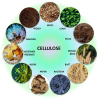Cellulose-Based Hybrid Hydrogels for Tissue Engineering Applications: A Sustainable Approach
- PMID: 40558737
- PMCID: PMC12192461
- DOI: 10.3390/gels11060438
Cellulose-Based Hybrid Hydrogels for Tissue Engineering Applications: A Sustainable Approach
Abstract
Cellulose is a sustainable biopolymer, being renewable and abundant, non-toxic, biodegradable, and easily functionalizable. However, the development of hydrogels for tissue engineering applications presents significant challenges that require interdisciplinary expertise, given the intricate and dynamic nature of the human body. This paper delves into current research focused on creating advanced cellulose-based hydrogels with tailored mechanical, biological, chemical, and surface properties. These hydrogels show promise in healing, regenerating, and even replacing human tissues and organs. The synthesis of these hydrogels employs a range of innovative techniques, including supramolecular chemistry, click chemistry, enzyme-induced crosslinking, ultrasound, photo radiation, high-energy ionizing radiation, 3D printing, and other emerging methods. In the realm of tissue engineering, various types of hydrogels are explored, such as stimuli-responsive, hybrid, injectable, bio-printed, electrospun, self-assembling, self-healing, drug-releasing, biodegradable, and interpenetrating network hydrogels. Moreover, these materials can be further enhanced by incorporating cell growth factors, biological molecules, or by loading them with cells or drugs. Looking ahead, future research aims to engineer and tailor hydrogels to meet specific needs. This includes exploring safer and more sustainable materials and synthesis techniques, identifying less invasive application methods, and translating these studies into practical applications.
Keywords: carboximethyl cellulose; cellulose; cellulose derivatives; hydrogels; hydroxypropylcellulose; methyl cellulose; scaffolds; stimuli responsive hydrogels; sustainable resources; tissue engineering.
Conflict of interest statement
The authors declare no conflicts of interest.
Figures












Similar articles
-
Comparison of cellulose, modified cellulose and synthetic membranes in the haemodialysis of patients with end-stage renal disease.Cochrane Database Syst Rev. 2001;(3):CD003234. doi: 10.1002/14651858.CD003234. Cochrane Database Syst Rev. 2001. Update in: Cochrane Database Syst Rev. 2005 Jul 20;(3):CD003234. doi: 10.1002/14651858.CD003234.pub2. PMID: 11687058 Updated.
-
One-Step Surface Functionalization of Hydrogel-Based, Stimulus-Responsive 3D Microstructures for Human Stem Cells.ACS Appl Mater Interfaces. 2025 Jun 18;17(24):35316-35327. doi: 10.1021/acsami.5c08146. Epub 2025 Jun 5. ACS Appl Mater Interfaces. 2025. PMID: 40470977
-
Introducing the dataset for measuring centrality for sustainability-A case study of Pecinci municipality, Serbia.Data Brief. 2025 May 27;61:111714. doi: 10.1016/j.dib.2025.111714. eCollection 2025 Aug. Data Brief. 2025. PMID: 40534919 Free PMC article.
-
Home treatment for mental health problems: a systematic review.Health Technol Assess. 2001;5(15):1-139. doi: 10.3310/hta5150. Health Technol Assess. 2001. PMID: 11532236
-
Systemic pharmacological treatments for chronic plaque psoriasis: a network meta-analysis.Cochrane Database Syst Rev. 2021 Apr 19;4(4):CD011535. doi: 10.1002/14651858.CD011535.pub4. Cochrane Database Syst Rev. 2021. Update in: Cochrane Database Syst Rev. 2022 May 23;5:CD011535. doi: 10.1002/14651858.CD011535.pub5. PMID: 33871055 Free PMC article. Updated.
References
-
- Mukarakate C., Mittal A., Ciesielski P.N., Budhi S., Thompson L., Iisa K., Nimlos M.R., Donohoe B.S. Influence of Crystal Allomorph and Crystallinity on the Products and Behavior of Cellulose during Fast Pyrolysis. ACS Sustain. Chem. Eng. 2016;4:4662–4674. doi: 10.1021/acssuschemeng.6b00812. - DOI
-
- Lee C.M., Mittal A., Barnette A.L., Kafle K., Park Y.B., Shin H., Johnson D.K., Park S., Kim S.H. Cellulose Polymorphism Study with Sum-Frequency-Generation (SFG) Vibration Spectroscopy: Identification of Exocyclic CH2OH Conformation and Chain Orientation. Cellulose. 2013;20:991–1000. doi: 10.1007/s10570-013-9917-3. - DOI
Publication types
LinkOut - more resources
Full Text Sources

